
Hãy nhập câu hỏi của bạn vào đây, nếu là tài khoản VIP, bạn sẽ được ưu tiên trả lời.


Bài 4:
a; \(\dfrac{1}{4}\) - \(\dfrac{1}{5}\) = \(\dfrac{5}{20}\) - \(\dfrac{4}{20}\) = \(\dfrac{1}{20}\)
b; \(\dfrac{3}{5}\) - \(\dfrac{-1}{2}\) = \(\dfrac{6}{10}\) + \(\dfrac{5}{10}\) = \(\dfrac{11}{10}\)
c; \(\dfrac{3}{5}\) - \(\dfrac{-1}{3}\) = \(\dfrac{9}{15}\) + \(\dfrac{5}{15}\) = \(\dfrac{14}{15}\)
d; \(\dfrac{-5}{7}\) - \(\dfrac{1}{3}\)= \(\dfrac{-15}{21}\) - \(\dfrac{7}{21}\)= \(\dfrac{-22}{21}\)
Bài 5
a; 1 + \(\dfrac{3}{4}\) = \(\dfrac{4}{4}\) + \(\dfrac{3}{4}\) = \(\dfrac{7}{4}\) b; 1 - \(\dfrac{1}{2}\) = \(\dfrac{2}{2}\) - \(\dfrac{1}{2}\) = \(\dfrac{1}{2}\)
c; \(\dfrac{1}{5}\) - 2 = \(\dfrac{1}{5}\) - \(\dfrac{10}{5}\) = \(\dfrac{-9}{5}\) d; -5 - \(\dfrac{1}{6}\) = \(\dfrac{-30}{6}\) - \(\dfrac{1}{6}\) = \(\dfrac{-31}{6}\)
e; - 3 - \(\dfrac{2}{7}\)= \(\dfrac{-21}{7}\) - \(\dfrac{2}{7}\)= \(\dfrac{-23}{7}\) f; - 3 + \(\dfrac{2}{5}\) = \(\dfrac{-15}{5}\) + \(\dfrac{2}{5}\)= - \(\dfrac{13}{5}\)
g; - 3 - \(\dfrac{2}{3}\) = \(\dfrac{-9}{3}\) - \(\dfrac{2}{3}\) = \(\dfrac{-11}{3}\) h; - 4 - \(\dfrac{-5}{7}\) = \(\dfrac{-28}{7}\)+ \(\dfrac{5}{7}\) = - \(\dfrac{23}{7}\)

Bài 5:
a. Gọi $d=ƯCLN(n-2, n+1)$
$\Rightarrow n-2\vdots d; n+1\vdots d$
$\Rightarrow (n+1)-(n-2)\vdots d$
$\Rightarrow 3\vdots d\Rightarrow d\in \left\{1; 3\right\}$
Để ps tối giản thì $n-2\not\vdots 3$
$\Leftrightarrow n\neq 3k+2$ với $k$ là số tự nhiên bất kỳ.
b.
Gọi $d=ƯCLN(n+5, n-2)$
$\Rightarrow n+5\vdots d; n-2\vdots d$
$\Rightarrow (n+5)-(n-2)\vdots d$
$\Rightarrow 7\vdots d$
$\Rightarrow d\in \left\{1; 7\right\}$
Để ps tối giản thì $n-2\not\vdots 7$
$\Rightarrow n\neq 7k+2$ với $k$ là số tự nhiên bất kỳ.

2. Các cặp số đối với nhau là:
\(\dfrac{-5}{6}\) và \(\dfrac{5}{6}\)
\(\dfrac{-40}{-10}\) và \(\dfrac{40}{-10}\)

Bài 2:
\(\dfrac{12}{-24}=\dfrac{12:12}{-24:12}=\dfrac{1}{-2}\)
\(\dfrac{-39}{75}=\dfrac{-39:3}{75:3}=\dfrac{-13}{25}\)
\(\dfrac{132}{-264}=\dfrac{132:132}{-264:132}=\dfrac{1}{-2}\)
Bài 3:
\(\dfrac{1}{-2}=\dfrac{-1}{2};\dfrac{-3}{-5}=\dfrac{3}{5};\dfrac{2}{-7}=\dfrac{-2}{7}\)
Bài 4:
\(15p=\dfrac{1}{4}h;20p=\dfrac{1}{3}h;45p=\dfrac{3}{4}h;50p=\dfrac{5}{6}h\)

Bài 1:
a; 24 ⋮ \(x\); 30 ⋮ \(x\); 48 \(⋮\) \(x\) và \(x\) lớn nhất.
vì 24 \(⋮\) \(x\); 30 ⋮ \(x\); 48 ⋮ \(x\) ⇒ \(x\) \(\in\) ƯC(24; 30; 48)
Vì \(x\) là lớn nhât nên \(x\) \(\in\) ƯCLN(24; 30; 48)
24 = 22.33; 30 = 2.3.5; 48 = 24.3
ƯCLN(24; 30; 48) = 2.3 = 6
⇒ \(x\) = 6
Vậy \(x\) = 6
b; 120 ⋮ \(x\); 180 ⋮ \(x\); 30 ⋮ \(x\)
⇒ \(x\) \(\in\) ƯC(120; 180; 390)
120 = 23.3.5; 180 = 22.32.5; 390 = 2.3.5.13
ƯC(120; 180; 390) = 2.3.5 = 30
⇒ \(x\in\) Ư(30) = {1; 2; 3; 5; 6; 10;15; 30}
Vì 5 ≤ \(x\) ≤ 15 nên \(x\) \(\in\) {5; 6; 10; 15}

Bài 2:
Chiều cao trung bình của 8 bạn trong tổ 1 là:
115 : 8 = \(\dfrac{115}{8}\) (dm)
Chiều cao trung bình của 10 bạn trong tổ 2 là:
138 : 10 = \(\dfrac{69}{5}\) (dm)
\(\dfrac{115}{8}\) = \(\dfrac{115\times5}{8\times5}\) = \(\dfrac{575}{40}\)
\(\dfrac{69}{5}\) = \(\dfrac{69\times8}{5\times8}\) = \(\dfrac{552}{40}\)
Vì \(\dfrac{575}{40}\) > \(\dfrac{552}{40}\)
Vậy chiều cao trung bình của các bạn tổ 1 lớn hơn chiều cao trung bình của các bạn tổ 2
Bài 3:
a; \(\dfrac{-11}{5}\) < \(\dfrac{-10}{5}\) = -2
\(\dfrac{-7}{4}\) > \(\dfrac{-8}{4}\) = - 2
\(\Rightarrow\) \(\dfrac{-11}{5}\) < \(\dfrac{-7}{4}\)
b; \(\dfrac{2020}{-2021}\) > - 1
\(\dfrac{-2022}{2021}\) < -1
Vậy \(\dfrac{2020}{-2021}\) > \(\dfrac{-2022}{2021}\)

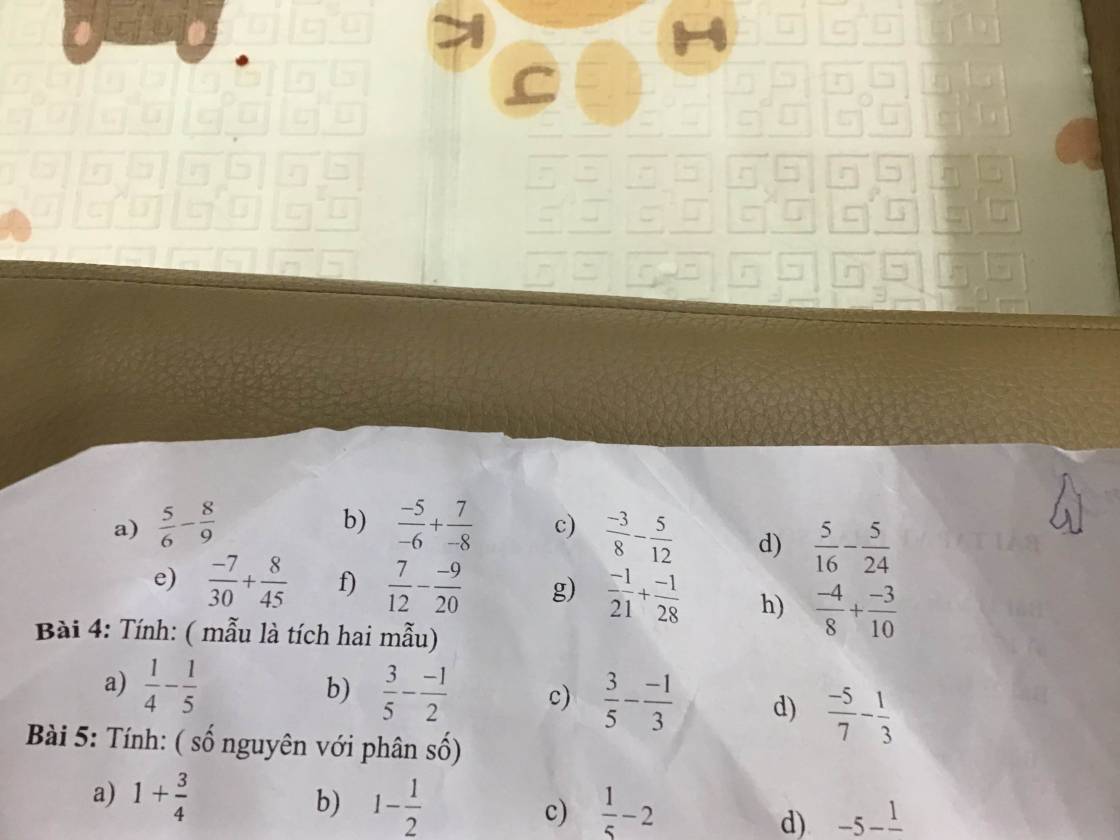
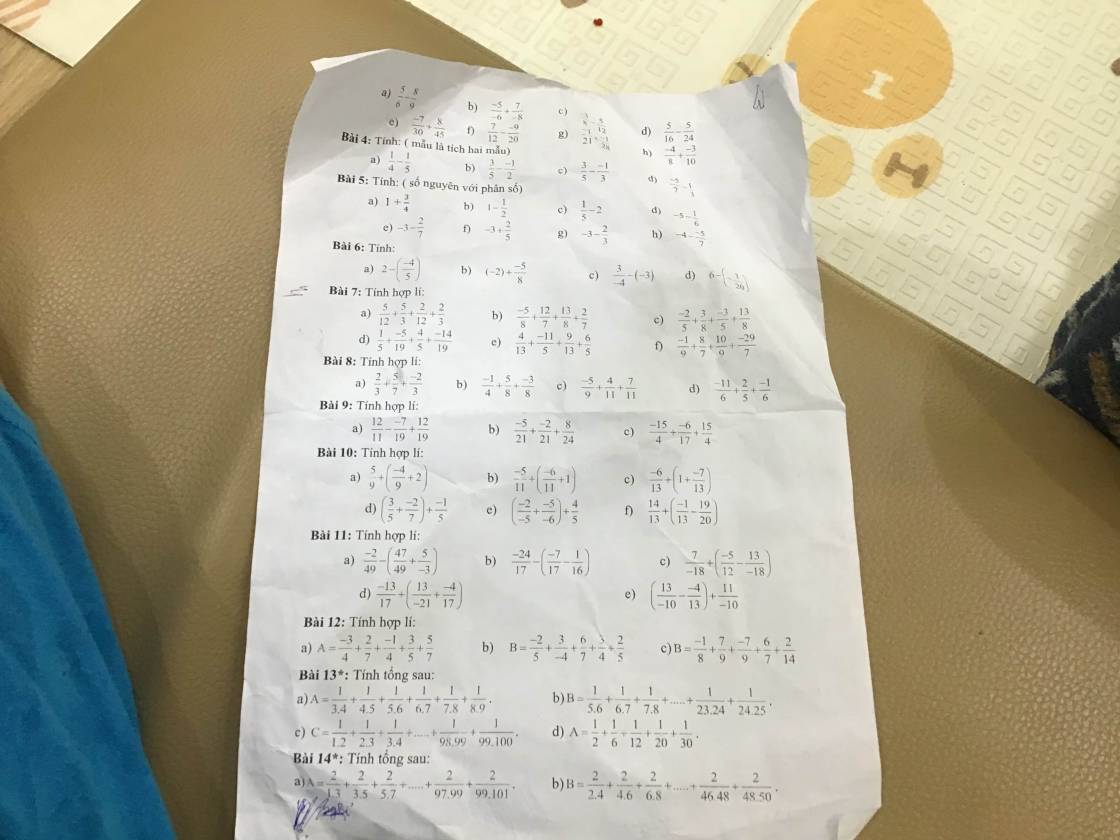

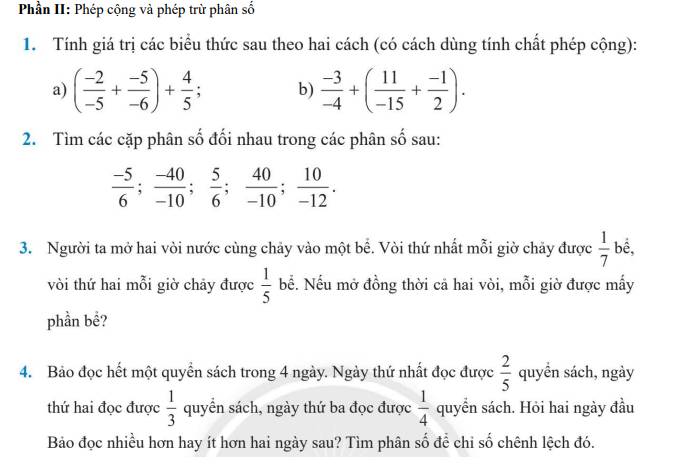
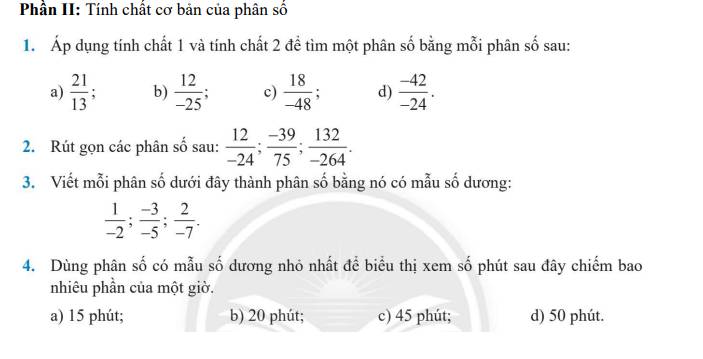
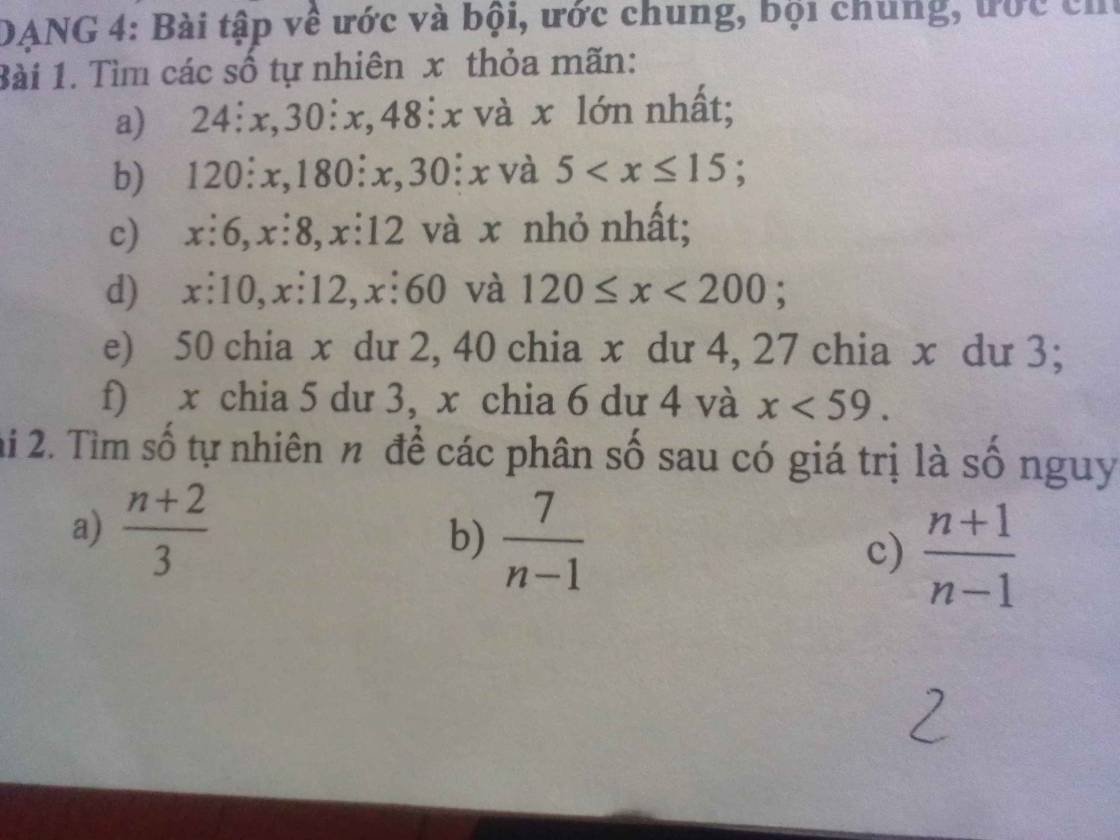
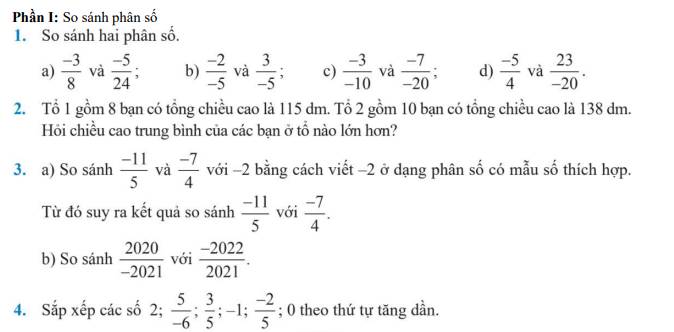
Bài 1: Bài 4: \(x\in\) Z biết:
4\(x-3\) ⋮ \(x\) + 2 (\(x\ne\) - 2)
4\(x\) + 8 - 11 ⋮ \(x\) + 2
4.(\(x\) + 2) - 11 ⋮ \(x\) + 2
11 ⋮ \(x\) + 2
\(x\) + 2 \(\in\) Ư(11) = {-11; - 1; 1; 11}
\(x\) \(\in\) {-13; -3; -1; 9}
Bài 5:
\(x\in\) Z ; 3\(x\) - 4 \(⋮\) 4\(x\) + 1
(3\(x\) -4).4 ⋮ 4\(x\) + 1
12\(x\) - 16 ⋮ 4\(x\) + 1
3.(4\(x\) + 1) - 19 ⋮ 4\(x\) + 1
19 ⋮ 4\(x\) + 1
4\(x\) + 1 \(\in\) Ư(19) = {-19; -1; 1; 19}
\(x\in\) { - 5; - \(\dfrac{1}{2}\); 0; \(\dfrac{9}{2}\))
Vì \(x\in\) Z nên \(x\) \(\in\) {-5; 0}